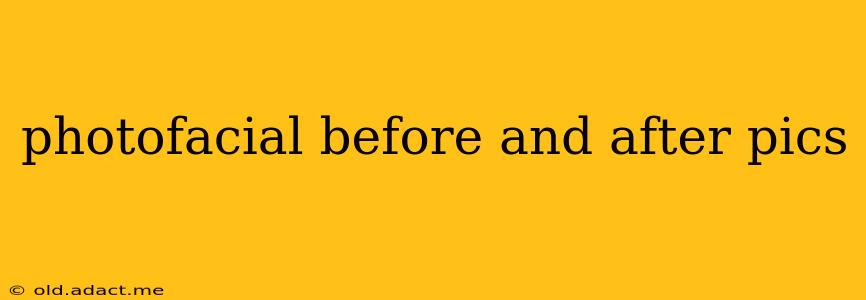Photofacials have become increasingly popular as a non-invasive way to improve skin tone and texture. But seeing the results firsthand—through before and after pictures—can significantly impact your decision to undergo the procedure. This guide explores what to expect from a photofacial, providing insights into before and after images and addressing common questions.
What is a Photofacial?
A photofacial, also known as intense pulsed light (IPL) therapy, is a non-invasive cosmetic procedure that uses pulses of broad-spectrum light to target various skin concerns. This light energy penetrates the skin, stimulating collagen production and breaking down pigment clusters responsible for age spots, sun damage, redness, and broken capillaries. The result is often brighter, clearer, and more even-toned skin.
What to Expect Before a Photofacial
Before your treatment, your dermatologist will likely conduct a thorough consultation to assess your skin type, concerns, and medical history. They'll discuss your expectations, explain the procedure in detail, and provide specific pre-treatment instructions. These often include avoiding sun exposure and certain medications in the days leading up to the treatment. You might also be advised to discontinue the use of certain topical skincare products.
How Long Does the Treatment Take?
The duration of a photofacial varies depending on the treated area and the extent of the skin concerns. A typical treatment session can take anywhere from 15 to 45 minutes.
What Does It Feel Like?
Most patients describe the sensation during a photofacial as a series of mild rubber band snaps or warm tingling on the skin. A cooling gel is usually applied beforehand to enhance comfort.
Photofacial Before and After: What to Look For
The dramatic before-and-after photos you see online are usually the result of multiple treatments, not just one session. It's crucial to manage expectations. While improvements are often noticeable after a single treatment, optimal results are typically achieved after a series of sessions spaced several weeks apart. The number of sessions necessary will be determined during your consultation, based on your individual needs.
Before-and-after pictures should showcase a gradual improvement in skin clarity, reduced redness, and a more even skin tone. Look for pictures that clearly show the patient's skin before treatment, highlighting the specific concerns addressed, and then the progressive improvement in skin condition across multiple sessions. Avoid photos that appear overly edited or enhanced.
Photofacial Before and After: Common Results
Improved Skin Tone: Photofacials effectively target hyperpigmentation, leading to a more even and brighter complexion. This is frequently evident in before-and-after photos.
Reduced Redness: The treatment can help minimize redness caused by rosacea or sun damage, leading to a calmer, more balanced complexion.
Minimized Age Spots and Sun Damage: Photofacials can fade age spots, sun spots, and freckles, resulting in a more youthful appearance.
Potential Side Effects and Risks
While generally safe, photofacials can have some potential side effects, such as temporary redness, swelling, and mild discomfort. These are typically short-lived and resolve quickly. More serious side effects are rare but include blistering, scarring, and changes in skin pigmentation. A qualified dermatologist will carefully assess your suitability for the procedure and discuss all potential risks.
How Long Do the Results Last?
The longevity of the results varies depending on individual factors, such as sun exposure and skin type. Maintaining a consistent skincare routine, including daily sunscreen use, is essential to prolong the results. Regular touch-up treatments may be recommended to maintain the improvements.
What About Pain?
While discomfort is minimal for most, some patients may experience mild discomfort during the treatment. The sensation is usually well-tolerated and temporary.
How Many Treatments Are Needed?
The number of photofacial treatments needed varies significantly depending on the individual and the specific skin concerns. Your dermatologist will provide a personalized treatment plan outlining the number of sessions needed to achieve optimal results.
How Much Does a Photofacial Cost?
The cost of a photofacial varies based on location, clinic, and the number of treatments needed. It's essential to discuss pricing with your dermatologist during your initial consultation.
Disclaimer: This information is for educational purposes only and should not be considered medical advice. Consult with a qualified dermatologist to determine if a photofacial is appropriate for you and to discuss potential risks and benefits. Always review before-and-after photos with a critical eye, understanding that results vary from person to person.
